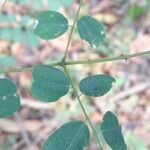Shrub, woody vine, shrub or tree, the branchlets armed. Leaves with 8-20 leaflets, these oblong, 1.5-3.5 cm. long, 0.8-2 cm. wide, obtusely truncate, thin-coriaceous, glabrous at maturity, the costa often immersed above, the main veins crowded; petioles 1-2.5 cm. long; rachises 2-5 cm. long. Panicles terminal, up to 15 cm. long; stipules spiniform, subulate, up to 1 cm. long, reflexed, glabrous toward the tip; pedicels about 2 mm. long; bracteoles orbicular, 1.5 mm. long. Flowers with the hypanthium about 5 mm. long, glabrous to puberulent, venose within, the teeth evanescent, about 0.6 mm. long; vexillum subrotund, broader than long, about 7.5 mm. wide, villosulose, shortly auriculate at the base, the claw about 3.5 mm. long; wing petals oblong, about 8 mm. long, obtuse, truncate at the base; carinal petals subreniform, about 9 mm. long, glabrous; stamens monadel-phous, the filaments about 1\2 the length of the sheath, the anthers about 0.65 mm. long, scarcely wider than the filaments; ovary stipitate for about 6 mm., densely sericeous to glabrescent, falcately oblong, the style about 3 mm. long. Fruits strongly lunate (appearing orbicular), 2-3 cm. long, 2-3 cm. wide, flat, rugulose, moderately puberulent.
More
A shrub or small tree. It can be climbing. It keeps growing from year to year. It grows 15 m long. The stems are cylinder shaped and 12 cm across. There are curved spines. The leaves are compound with 5-7 leaflets along the stalk. They are alternate. The leaflets are 2-7 cm long by 1-3 cm wide. The flowering shoots are in the axils of leaves or at the ends of the branches. The flowering shoots are 5-15 cm long. The pod is 2-4 cm wide. It is curved and has one kidney shaped seed.
In the coastal swamps that border on the mangroves in Puerto Rico. Swampy places, along salt marshes and tidal river estuaries, often in association with the mangrove community in west Africa.
More
A tropical plant. It grows along river banks and on the edges of mangroves.


